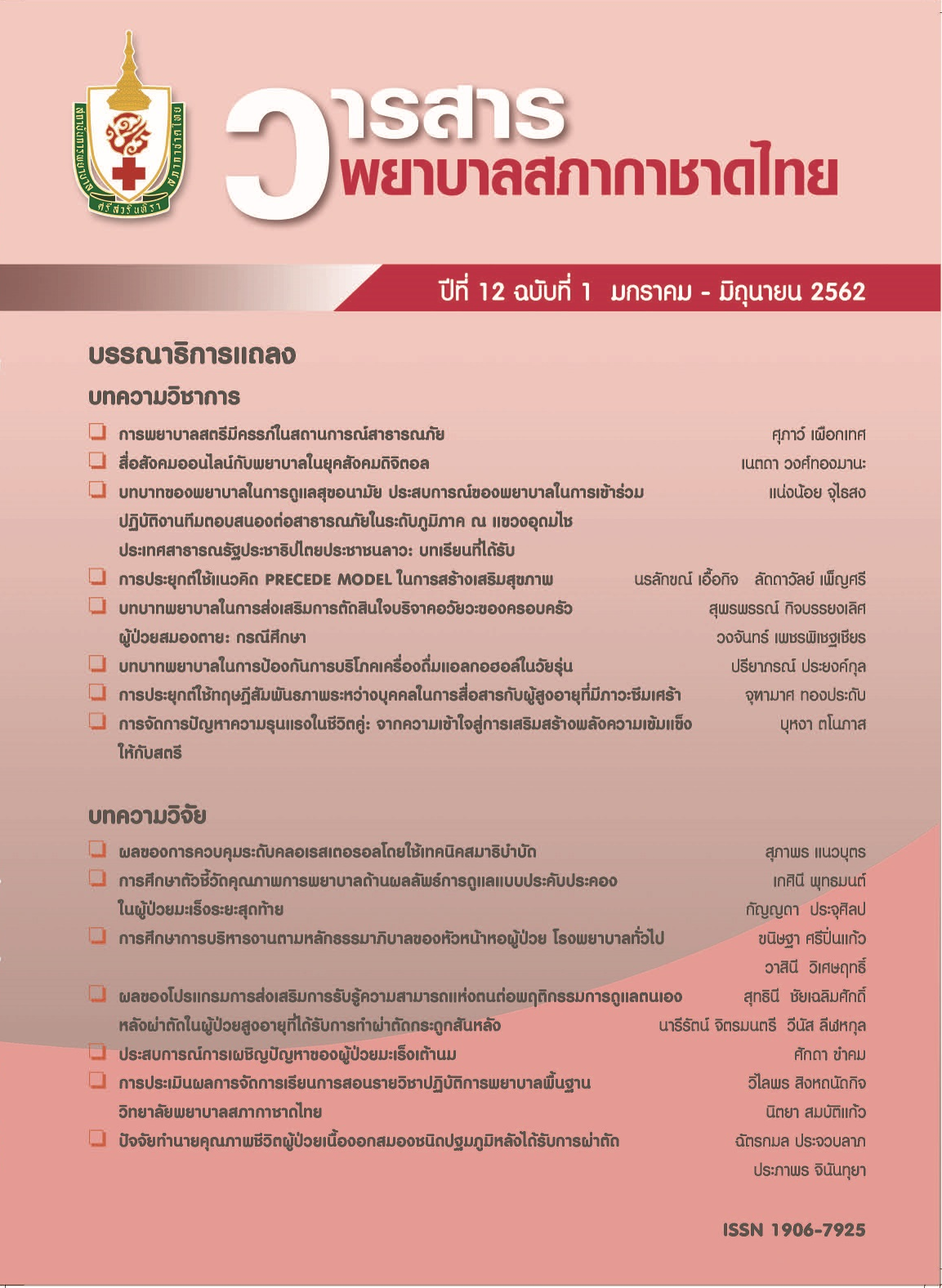A Study of Palliative Care Nursing Outcomes Quality Indicators, Patients with Cancer in the Terminal Stage
Keywords:
palliate care, cancer in terminal stage, nursing outcome, quality indicatorsAbstract
The purpose of this research was to identify the palliative care nursing outcomes quality indication for patients with cancer in the terminal stage by using the Delphi technique. Eighteen experts agreed to participate in this research related to care patients with cancer in the terminal stages. The questionnaires were developed by the researcher and used as the research instrument with modified Delphi technique. They were developed in 3 major steps. Step 1: Using semi-open ended questionnaires, the experts were asked to identify the nursing outcomes quality indicators for patients with cancer in the terminal stages. Step 2: The data received from the first stage was analyzed to develop the rating scale questionnaires. Step 3: Questionnaire items were analyzed by using the median and interquartile range, then sent back to the experts for their confirmation.
According to the research, the palliative care nursing outcomes quality indicators for patients with cancer in the terminal stage comprised 6 categories and 37 indicators: 1) Pain relief of the patient (5 indicators); 2) Relief of physical disturbances of the patient (8 indicators); 3) The safety of the patient from complications (4 indicators); 4) The responses of mental, phychosocial, and spiritual needs of the patient and family (5 indicators); 5) Coping and adaptation of the patient and family (8 indicators); and 6) Coping with the dying of the patient and family (7 indicators).
References
2. อุมาภรณ์ ไพศาลสุทธิเดช. บทบาทพยาบาลในการดูแลผู้ป่วยระยะสุดท้าย. การประชุมฟื้นฟูวิชาการ เรื่อง “วิทยาการก้าวหน้าในการพยาบาลผู้ป่วยโรคมะเร็ง” (Best Practice for Cancer care). วันที่ 21 ก.พ. 2556; ห้องประชุม นพ. พงษ์ศักดิ์ วิทยากร(7R) ชั้น 7 อาคารเวชศาสตร์ฟื้นฟู โรงพยาบาลกรุงเทพ. กรุงเทพฯ: สมาคมพยาบาลโรคมะเร็งแห่งประเทศไทย; 2556.
3. ปฐมวดี สิงห์ดง, ชนกพร จิตปัญญา. ประสบการณ์ของสมาชิกครอบครัวในหอผู้ป่วยวิกฤต: การวิจัยเชิงคุณภาพ. Rama Nurs J 2555;18(3):404-17.
4. ผาณิต หลีเจริญ. การดูแลผู้ป่วยระยะสุดท้าย: สะท้อนคุณค่าวิชาชีพ. วารสารมหาวิทยาลัยหัวเฉียวเฉลิมพระเกียรติวิชาการ 2557;17(34):127-36.
5. เพ็ญจันทร์ สิทธิปรีชาชาญ. การแบ่งปันประสบการณ์การดูแลแบบประคับประคองสำหรับผู้ป่วยระยะท้าย. Journal of Nursing Science 2556;31(3):18-26.
6. National Cancer Institute. Palliative Care in Cancer [Internet]. 2010 [cited 2016 Jan 19]. Available from: https://www.cancer.gov/about-cancer/advanced-cancer/care-choices/palliative-care-fact-sheet
7. ชมรมพยาบาลแบบประคับประคอง. วัตถุประสงค์ของชมรม [อินเตอร์เน็ต]. 2557 [เข้าถึงเมื่อ 20 ม.ค. 2559]. เข้าถึงได้จาก: https://palliativenursessocity.wordpress.com/
8. โรงพยาบาลชลบุรี. มาตรฐานการปฏิบัติการพยาบาลผู้ป่วยแบบประคับประคอง [อินเทอร์เน็ต]. 2555 [เข้าถึงเมื่อ 19 ม.ค. 2559]. เข้าถึงได้จาก: www.cbh.moph.go.th
9. ยุวนุช ทินนะลักษณ์. การดูแลผู้ป่วยแบบประคับประคอง. การประชุมวิชาการชมรมพยาบาลแบบประคับประคอง รูปแบบการดูแลผู้ป่วยแบบประคับประคอง วันที่ 20-21 ธันวาคม 2557; ห้องประชุมสกายบอลรูมชั้น 9 โรงแรมแม็กซ์. กรุงเทพฯ: ชมรมพยาบาลแบบประคับประคอง; 2557.
10. De Roo ML, Leemans K, Claessen SJ, Cohen J, Pasman HR, Deliens L, et al. Quality indicators for palliative care: update of a systematic review. J Pain Symptom Manage 2013;46(4):556-72.
11. Pasman HR, Brandt HE, Deliens L, Francke AL. Quality indicators for palliative care: a systematic review. J Pain Symptom Manage 2009;38(1):145-156.
12. Moorhead S, Johnson M, Maas ML, Swanson E. Nursing Outcomes Classification (NOC): measurement of health outcomes. 5th ed. Philadelphia: Elsevier; 2013.
13. Mantas J. Textbook in health informatics: a nursing perspective. Amsterdam: IOS Press; 2002.
14. กฤษฎา แสวงดี. ตัวชี้วัดคุณภาพการพยาบาลในโรงพยาบาล. กรุงเทพฯ: สามเจริญพาณิชย์; 2547.
15. สำนักงานหลักประกันสุขภาพแห่งชาติ (สปสช.). คู่มือการใช้แบบประเมินผลลัพธ์การดูแลแบบประคับประคอง (Palliative care outcomes scale: POS). เชียงใหม่: กลางเวียงการพิมพ์; 2556.
16. สำนักการพยาบาล สำนักงานปลัดกระทรวง กระทรวงสาธารณสุข. ระบบบริการพยาบาลแบบประคับประคอง. นนทบุรี: สำนักพิมพ์สื่อตะวัน; 2559.
17. Dunlop R. Cancer: palliative care. London: Springer; 1998.
18. National Consensus Project for Quality Palliative care. Clinical practice guidelines for quality palliative care. 3rd ed. Pittsburgh, PA: National Consensus Project for Quality Palliative care; 2013.
19. ชัยลิขิต สร้อยเพชรเกษม. การวิจัยด้วยวิธีเดลฟาย: การใช้มติสอดคล้องโดยเสียงข้างมาก. วารสารวิชาการบัณฑิตศึกษามหาวิทยาลัยราชภัฏนครสวรรค์ 2555;7(18):1-13.
20. สำนักงานหลักประกันสุขภาพแห่งชาติ (สปสช.). ก่อนจะถึงวันสุดท้าย. กรุงเทพฯ: สำนักงานหลักประกันสุขภาพแห่งชาติ; 2554.
21. World Health Organization. WHO definition of palliative care [Internet]. 2012 [cited 2016 Jan 20]. Available from: https://www.who.int/cancer/palliative/definition/en/
22. กิตติกร นิลมานัต, วงจันทร์ เพชรพิเชษฐเชียร, วันธนีย์ วิรุฬห์พานิช, สุรีพร กฤษเจริญ. รายงานการวิจัยเรื่อง การสำรวจประสบการณ์อาการที่พบบ่อยและการจัดการกับอาการของผู้ป่วยมะเร็งในประเทศไทย. สงขลา: มหาวิทยาลัยสงขลานครินทร์; 2551.
23. สมาคมการศึกษาเรื่องความปวดแห่งประเทศไทย. แนวทางเวชปฏิบัติภาวะปวดเหตุพยาธิสภาพระบบประสาท. กรุงเทพฯ: บียอนด์ อินเตอร์ไพรซ์; 2551.
24. Seow H, Snyder CF, Mularski RA, Shugarman LR, Kutner JS, Lorenz KA, et al. A framework for assessing quality indicators for cancer care at the end of life. J Pain Symptom Manage 2009;38(6):903-12.
25. Mello BS, Massutti TM, Longaray VK, Trevisan DF, Lucena Ade F. Applicability of the nursing outcomes classification (NOC) to the evaluation of cancer patients with acute or chronic pain in palliative care. Appl Nurs Res 2016;29:12-8.
26. กรมการแพทย์กระทรวงสาธารณสุข. แนวทางการดูแลผู้ป่วยระยะสุดท้าย [อินเตอร์เน็ต]. 2557 [เข้าถึงเมื่อ 10 ก.พ. 2559]. เข้าถึงได้จาก: https://www.dms.moph.go.th/dmsweb/index_original.php
27. กรีฑา ธรรมคัมภีร์, บรรณาธิการ. ตำรามะเร็งปอด. สงขลา: ชานเมืองการพิมพ์; 2550.
28. กิติพล นาควิโรจน์. Dyspnea in palliative care [อินเตอร์เน็ต]. 2015 [เข้าถึงเมื่อ 10 พ.ย. 2560]. เข้าถึงได้จาก: https://med.mahidol.ac.th/fammed/th/postgrad/doctorpalliative14th
29. พิมพ์พนิต ภาศรี. ทรรศนะของครอบครัวและความต้องการการช่วยเหลือในการดูแลผู้ป่วยมะเร็งระยะสุดท้าย [วิทยานิพนธ์หลักสูตรพยาบาลศาสตรมหาบัณฑิต สาขาการพยาบาลเวชปฏิบัติชุมชน]. สงขลา: มหาวิทยาลัยสงขลานครินทร์; 2557.
30. จุรีย์ เพชรน้ำแหลม, กิตติกร นิลมานัตร, จารุวรรณ มานะสุรการ. ประสบการณ์อาการ การจัดการและผลลัพธ์การจัดการอาการของผู้ป่วยมะเร็งตับ. บทความวิจัยเสนอในการประชุมหาดใหญ่วิชาการ ครั้งที่ 4; วันที่ 10 พฤษภาคม 2556; มหาวิทยาลัยหาดใหญ่. สงขลา: มหาวิทยาลัยหาดใหญ่; 2556. หน้า 161-9.
31. สุรเกียรติ อาชานานุภาพ. ปอดบวม ปอดอักเสบ (Pneumonia). กรุงเทพฯ: หมอชาวบ้าน; 2547.
32. Raijmakers N, Galushko M, Domeisen F, Beccaro M, Lundh Hagelin C, Lindqvist O, et al. Quality indicators for care of cancer patients in their last days of life: literature update and experts’ evaluation. J Palliat Med 2012;15(3):308-16.
33. ผาณิต หลีเจริญ. การดูแลผู้ป่วยระยะสุดท้าย: สะท้อนคุณค่าวิชาชีพ. วารสาร มฉก.วิชาการ 2557;17(34):127-36.
34. สมพร ปานผดุง, กิตติกร นิลมานัต, ลัพณา กิจรุ่งโรจน์. ความผาสุกทางจิตวิญญาณของญาติผู้ดูแลผู้ป่วยมะเร็งทางนรีเวชระยะลุกลามในโรงพยาบาล. บทความวิจัยเสนอในการประชุมหาดใหญ่วิชาการครั้ง 4; วันที่ 10 พฤษภาคม 2556; มหาวิทยาลัยหาดใหญ่. สงขลา: มหาวิทยาลัยหาดใหญ่; 2556. หน้า195-204.
35. Miyashita M, Nakamura A, Morita T, Bito S. Identification of quality indicators of end-of-life cancer care from medical chart review using a modified Delphi method in Japan. Am J Hosp Palliat Care 2008;25(1):33-8.
36. Claessen SJ, Francke AL, Belarbi HE, Pasman HR, van der Putten MJ, Deliens L. A new set of quality indicators for palliative care: process and results of the development trajectory. J Pain Symptom Manage 2011;42(2):169-82.
37. จอนผะจง เพ็งจาด. บทบาทการพยาบาลในการดูแลผู้ป่วยแบบประคับประคอง. วารสารวิทยาลัยพยาบาลบรมราชชนนีกรุงเทพ 2557;30(1):100-9.
38. วารุณี มีเจริญ. ญาติผู้ดูแลผู้ป่วยมะเร็ง: การปรับตัวต่อบทบาทและการส่งเสริมคุณภาพชีวิต. รามาธิบดีพยาบาลสาร 2557;20(1):10-9.
39. พิกุล พรพิบูลย์. แนวโน้มการพยาบาล เรื่อง การดูแลผู้ป่วยแบบประคับประคอง. เอกสารการบรรยายในการประชุมวิชาการ Suandok Palliative Care Day ครั้งที่ 6; วันที่ 14 พฤษภาคม 2558; ณ ห้องประชุมเชียงแสน โรงแรงดวงตะวัน จ.เชียงใหม่; 2558.
40. แสวง บุญเฉลิมวิภาส. หลักการมาตรา 12 ของ พ.ร.บ.สุขภาพแห่งชาติ [อินเทอร์เน็ต]. 2551 [เข้าถึงเมื่อ 27 ก.พ. 2561]. เข้าถึงได้จาก: www.cbo.moph.go.th/.../bamnan/หลักการมาตรา%2012%20ของ%20พรบสุขภาพ60.pdf
41. สถาพร ลีลานันทกิจ. คู่มือการดูแลรักษาสุขภาพผู้ป่วยระยะสุดท้ายของชีวิต. กรุงเทพฯ: โรงพิมพ์ชุมนุมสหกรณ์การเกษตรแห่งประเทศไทย; 2551.
42. วัลภา คุณทรงเกียรติ. การตายดีตามการรับรู้ของสมาชิกครอบครัวผู้ป่วย. วารสารคณะพยาบาลศาสตร์ มหาวิทยาลัยบูรพา 2558;23(3):41-53.
Downloads
Published
Issue
Section
License
เนื้อหาบทความหรือข้อคิดเห็นต่างๆ ในวารสารพยาบาลสภากาชาดไทยนี้ เป็นความคิดเห็นของผู้เขียนบทความ ไม่ใช่ความเห็นของกองบรรณาธิการ หรือสถาบันการพยาบาลศรีสวรินทิรา สภากาชาดไทย






